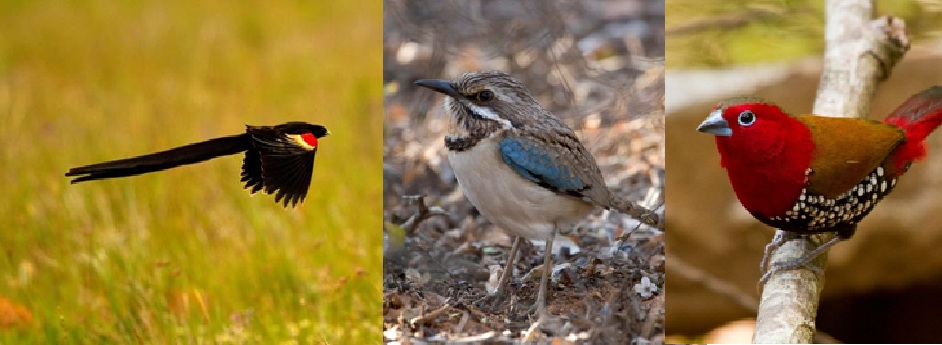Birdwatching has just been taken to another level with a recent research article showing that sub-Saharan Africa has greater bird diversity than South America and the rest of the world.
The article "Beyond just species: Is Africa the most taxonomically diverse bird continent?" was published in the latest edition of the South African Journal of Science.
According to one of the authors, birding specialist Dr Chris Lotz, Africa is generally not regarded as the most diverse bird continent: "The common perception is that South America is the world's best birding destination. We are trying to show that if you look at a deeper level, sub-Saharan Africa has by far a genetically more diverse birdlife than the rest of the world."
In other words, when one moves beyond just counting species, a region with eight species from eight genera is obviously more diverse than a region with eight species but from only seven genera, Dr Lotz explains.
Called the taxonomic system of classification, these ranks – kingdom; phylum; class; order; family; genus, and species – show the kinship of animals, birds and plants. The order Coraciiforms, for example, is made up of ten families of birds that include the kingfishers, todies, motmots, bee-eaters, rollers, hoopoes and hornbills.
Dr Lotz worked with Prof Michael Cherry from the Department of Botany and Zoology at Stellenbosch University, and birding enthusiasts Ms Monika Forner and Dr John A Caddick, to do some simple maths to prove their point.
"We took eight areas in Africa that are similar in size and compared them with 16 similar regions spread across the world. For each region we downloaded bird lists from the world bird database Avibase, and then counted the number of species, genera, families and orders for each region," Dr Lotz explains.
Supported by Birdlife International, Avibase offers information about all birds of the world, with over nine million records about 10 000 species and 22 000 subspecies of birds.
Using simple regression analyses they tested for relationships between genus count, family count, order count, and the ratios between, for example, species:genus or species:family.
And the winners are…
Starting at the lowest taxonomic rank, South American countries like Colombia and Peru displayed the highest number of species, with 1 816 and 1 752 species respectively. But these are distributed in a surprisingly small number of families (85 and 87 respectively).
When one takes the comparison to a higher taxonomic level, Northern India has the world's largest number of families at 104. Sub-Saharan Africa boasts with 103 families in three regions, and 97 to 101 families in all the other sub-Saharan African regions.
Moving even higher up the taxonomic ranks to the level of order, sub-Saharan Africa comes out tops. There are 29 different orders of birds in Coastal West Africa, South Africa and Ethiopia-Eritrea and Angola, while Mozambique-Zimbabwe has the highest number of orders on the planet at 30.
According to the authors, no other continent contains regions with more than 28 orders: "In terms of higher taxonomy, sub-Saharan Africa is arguably the richest part of the planet for birds," they state in the article. With 1 324 species a chunk of East Africa, the same size as Colombia, also shows quite high diversity at the lowest taxonomic level, adds Dr Lotz
Coming in second place would be Northern India (again the same size as Colombia), with 1 161 species and 104 families, and with a remarkably high diversity at all taxonomic levels. This is especially surprising as it is not a tropical region.
These findings also hold significant implications for conservation efforts: "For example, there are eight endemic bird species in Malawi's Nyika National Park. They are distributed in seven genera, all of which are very widespread in Africa. But the eight species in Madagascar's Mikea Forest are in eight genera, one of which is found in no other Important Birding Area, and three of which are confined to the South Malagasy spiny forests Endemic Bird Area. The Mikea Forest should therefore be afforded a higher conservation priority," he argues.
The Important Birding Area Programme is an initiative of BirdLife International and aims to conserve a network of sites critical for the long-term survival of threatened bird species.
Whence this diversity?
According to SU zoologist Prof Michael Cherry, recent research attributes the deep-rooted avian diversity in sub-Saharan Africa to the Gondwanan origin of a large group of mainly terrestrial birds which includes the songbirds, Coraciiforms, Piciforms, owls, diurnal raptors, New World vultures, trogons, mousebirds, cuckoo-rollers, seriemas and parrots. They subsequently diversified in Australia, South America and Africa during the late Cretaceous to early Palaeogene.
"Although each continent may have originally included other groups, the only survivors today from the Australian radiation are the songbirds and parrots, while only the falcons and seriemas have survived the South American radiation. But the group of survivors from the African radiation is considerably taxonomically more diverse, including all the remaining taxa.
"This history, together with the great diversity of habitats in sub-Saharan Africa, has led to this region having the world's highest levels of avian diversity," he concludes.
Photos above, from left to right: long-tailed widow in South Africa (Photo: John Caddick, Birding Ecotours), long-tailed ground-roller in Madagascar (Photo: Ian Merril) and Peter's twinspot in Zimbabwe (Photo: John Caddick, Birding Ecotours).
Technical queries
Dr Chris Lotz
Cell: 072 211 9863
E-mail: birdingecotours@yahoo.co.uk
Prof Michael Cherry
Department of Botany and Zoology, Stellenbosch University
Tel: 021 808 3233
E-mail: mic@sun.ac.za
Media enquiries
Wiida Fourie-Basson
Media: Faculty of Science, Stellenbosch University
Tel: 021 808 2684
E-mail: science@sun.ac.za
